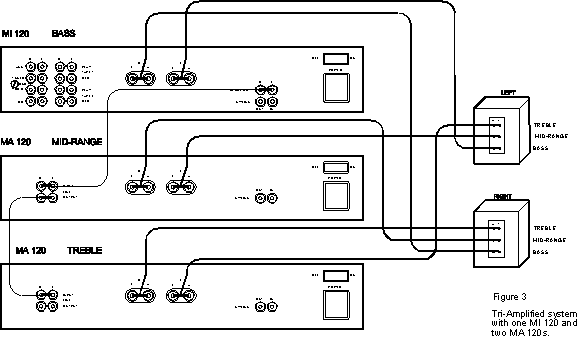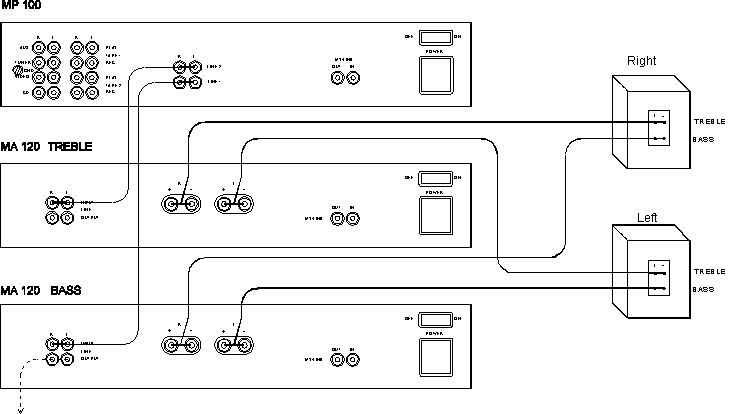

Myryad designed the MI 120 to integrate into a wide range of hi-fi systems and fulfil the requirements of most listeners. However, we realise that many people will want to expand their system, either to enhance the sound quality even further, or to extend the benefits of their Myryad system into other rooms. We developed the MA 120 Power Amplifier to meet these needs with a minimum of additional wiring and complexity.
For even higher quality sound and greater flexibility MP 100 preamplifier can be used with one or more MA 120 or MA 240 power amplifiers.
This paper describes how multi-amplifier systems can be built using:
· the MI 120 plus one MA 120 in “Bi-Amplifier” systems
· the MI 120 plus two MA 120s in “Tri-Amplifier” systems (with suitable loudspeakers).
· the MP 100 Preamplifier plus one or more MA 120s or MA 240s in Bi-Amp or Tri-Amp systems.
It also shows how the MI 120 or the MP 100 can feed one or more MA 120 or MA 240 Power Amplifiers for driving loudspeakers in other rooms.
The MI 120 plus MA 120 in “Bi-Amplified” SystemsMany loudspeakers today are produced with two sets of terminals to allow “Bi-Wiring”. In this configuration two sets of speaker cables are used to connect from one integrated amplifier (e.g. the MI 120) to the loudspeakers: the left channel of the amplifier is wired by one cable to the left speaker BASS terminals and also by a second cable to the left speaker TREBLE terminals – and the right channel is wired in a similar way. This arrangement is shown in Figure 1. Improved sound quality can result because the signal losses in the loudspeaker cables caused by the bass section cannot affect the treble – and vice versa.
The so called “Bi-Amplifier” mode of operation takes this principle one step further. Two power amplifier channels are used for each loudspeaker and each is wired by its own speaker cable to the relevant speaker section (Bass or Treble). Bi-Amplified operation with the MI 120 and MA 120 is shown in Figure 2 (above).
The MI 120 “BI-AMP” output level and the MA 120’s gain are set such that the MA 120 output voltage is identical to the MI 120 output so that the bass/treble balance of the loudspeaker is unchanged when it is bi-amplified.
In the bi-amplifier configuration both the MI 120 and the MA 120 carry the full bandwidth audio signal. However, the MI 120 only has to deliver output at low frequencies so the amplifier has a very easy task in reproducing the signal accurately. Conversely, the MA 120, as it is only loaded by the speakers’ treble sections, only drives significant output current at high frequencies and has to deliver almost no current on bass notes. This allows the MA 120 amplifier to operate with improved fidelity in delivering the critical signal transients as its power supply is only very lightly loaded.
In short, by restricting the bass power delivery to the MI 120 and the treble to the MA 120, interactions between bass and treble within each amplifier are very much reduced. The end result is a more transparent sound with more power and punch in the bass and a cleaner, sweeter top end. An additional advantage incurred with bi-amplification is that the total power consumed by the loudspeaker is now being drawn from two power supplies, with two massive toroidal transformers. The result is an increase in dynamics and peak power output – particularly with low impedance loudspeakers.
Alternatively the MI 120 may be used to drive the bass and the MA 120 the treble. This configuration will offer a slightly differently improved sound, which may be preferred in some systems.
Using the MA 240 with an MI 120 or mixed MA 120s and 240s with an MP 100 in Bi-Amp or Tri-Amp systemsIn the system described above the higher-powered higher quality MA 240 may be substituted for the MA 120. The MA 240 has the same gain (i.e. the same input signal required for a specific output power) so the system bass/treble balance will be the same, whichever power amplifier is used. The MA 240 offers a much higher sound quality than the MA 120 and can deliver considerably more output current, so it is likely to produce significantly better sound in such a bi-amp system. However, it will not result in any substantial increase in maximum sound level as the MA 240 will only be operating at 60 watts (half its maximum power) when the MI 120 is fully driven to its maximum output of 60 watts. These same points apply to mixing MA 120s and MA 240s in any bi-amp, tri-amp or multi-room system with the MI 120 or MP 100, such as those described below.
The MI 120 plus two MA 120s in “Tri-Amplified” SystemsThere is a growing number of three and four-way loudspeaker systems which are provided with three sets of terminals allowing tri-wiring or tri-amplifying, with separate feeds for bass, mid and treble frequencies.
The MA 120 is fitted with a pair of Line Outputs, wired in parallel with the Line Inputs, which allow a second MA 120 to be wired in parallel to the first – in “daisy-chain” fashion. This configuration is depicted in Figure 3 which shows how loudspeakers can be “Tri-Amplified” using one MI 120 and two MA 120s. The MI 120 drives the bass sections, the first MA 120 the mid and the second MA 120 drives the treble so that the overall performance is optimised in a similar way to that described for bi-amplifying.

The MI 120 or MP 100 with one or more MA 120s or MA 240s in Multi-Room systems
Once a high quality audio system is installed in your main listening room, you may find you want to the same sound quality in another room (or rooms). Installing separate sound systems in each room is one solution, but the cost and complexity is high – and you will always find the CD or record you want to play is in the other room…..!
Multi-room Hi-Fi installations are becoming ever more popular and many offer a great deal of flexibility – but at a considerable price. Myryad Systems offer a simple and inexpensive multi-room set-up using the MI 120 integrated amplifier, or MP 100 Preamplifier, together with one or more MA 120 or MA 240 power amplifiers. (In all instances below, wherever MA 120 is mentioned the MA 240 could be substituted, but the MA 240 is generally better suited to MP 100 based systems.)
The MI 120 is situated in your main listening room in your normal Hi-Fi system. Its BI-AMP output is fed to the Line Input of an MA 120 whose Line Output, in turn, is connected to the Line Input of a second MA 120, and so on. In this “daisy-chain” fashion a number of MA 120s (up to about 10) can be connected to the BI-AMP output of a single MI 120. There will be no adverse loading effect owing to the low output impedance of the MI 120 and high input impedance of the MA 120 (450 W and 100 kW respectively). This arrangement is shown in Figure 4.
Each MA 120 drives a single pair of loudspeakers in a separate room. The MA 120s can either be situated close to the MI 120 with speaker cables run off to each room (similar to the diagram in Figure 4), or each MA 120 could be located in a separate room with its loudspeakers – with long interconnects between the MI 120 and the MA 120s. In the latter case the daisy-chain wiring system may not be so convenient, so an adaptor which allows the MI 120 BI-AMP output to feed a number of cables (one cable to each MA 120) might be preferred. In either case, the maximum recommended total length of interconnect cable feeding the MA 120s is in the region of 20 to 50 metres (depending upon the cable capacitance and the number of MA 120s connected).
If you wish to estimate the maximum cable length for your system then you can use the following equation:
Maximum cable length (metres) = (7,800 – N x 450)/C for less than 1dB loss at 20 kHz
Where: N = Number of MA 120s wired to MI 120 and C = cable capacitance in pF/metre.
The MP 100 Preamplifier can also be used to drive a number of daisy-chained MA 120 or MA 240 Power Amplifiers. The MP 100 has a much lower output impedance (75 W) and so can drive longer cables. In practice the maximum capacitance loading is limited by the high frequency current demand on the MP 100’s output. The resulting cable length equation for the MP 100 is therefore:
Maximum cable length (metres) = (25,000 – N x 450)/C
“Bi-Amplified” and “Tri-Amplified” Systems using the MP 100 with MA 120 or MA 240 Power AmplifiersThe MP 100 Preamplifier forms an excellent foundation for building a high-end bi-amplifier or tri-amplifier system using either MA 120 or MA 240 Power Amplifiers. The principles of operation are just the same as for the MI 120 / MA 120 systems already described. The wiring arrangements for bi- and tri-amplifier systems are shown in Figure 5.

Figure 5
The MP 100 can be used with any power amplifiers in bi-amp or tri-amp systems, but it is important that all the amplifiers used have precisely matched gains. Any mis-match in the amplifier gains would produce an uneven frequency response from the loudspeakers. All Myryad power amplifiers have accurately matched gains.
It is also recommended that all the power amplifiers used in such a system have similar maximum power outputs (e.g. use all MA 120s or all MA 240s) for the reasons described on the previous page.
My-LinkIn all the systems described above the MI 120 or MP 100 can also be linked to the MA 120s or MA 240s through the MY-LINK communications channel. The MI 120 / MP 100’s “MY-LINK OUT” should be wired, using a single RCA phono lead, to the “MY-LINK IN” on the first MA 120/240 and thence from its “MY-LINK OUT” to the second amplifier and so on in daisy-chain fashion. With the system connected in this way, when the MI 120 / MP 100 is switched out of STANDBY (from the front panel or by remote control) all of the power amplifiers linked to it will be activated simultaneously. In addition, if the MI 120 / MP 100 is switched into MUTE via its remote control, then all the linked power amplifiers will mute and their power LEDs will flash to indicate this condition.
The use of the MY-LINK communications channel makes bi/tri-amplifier systems much more convenient to operate but is a BIG benefit in a multi-room system if some MA 120/240s are installed remotely.
If you need advice concerning your particular application, whether bi-amplification, tri-amplification or multi-room please ask your Myryad dealer, or write to Myryad Systems Ltd. at the address below.